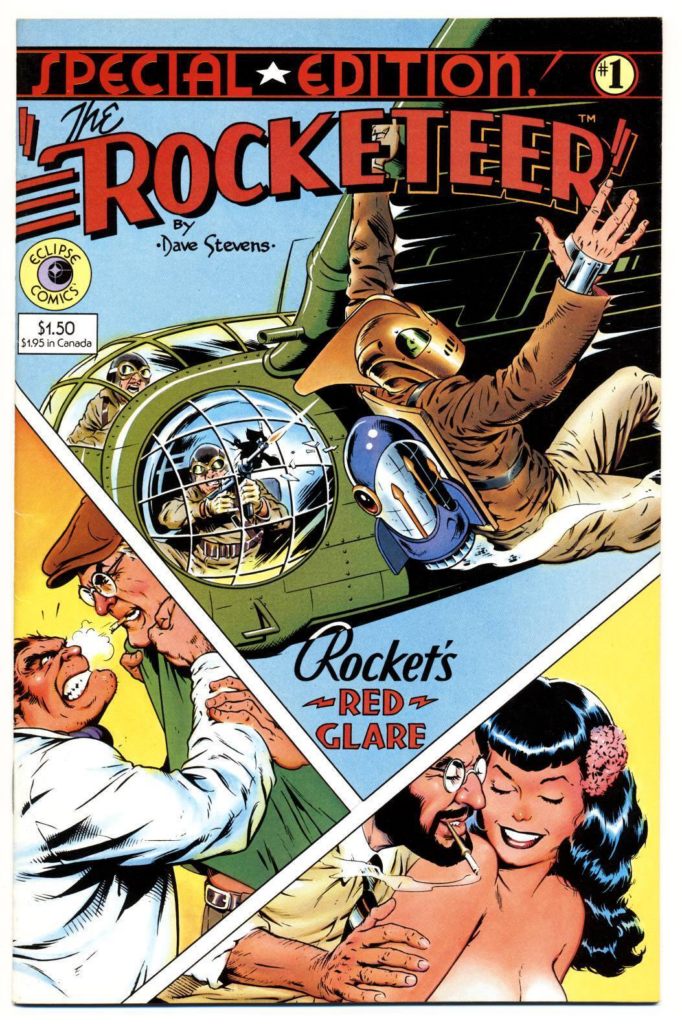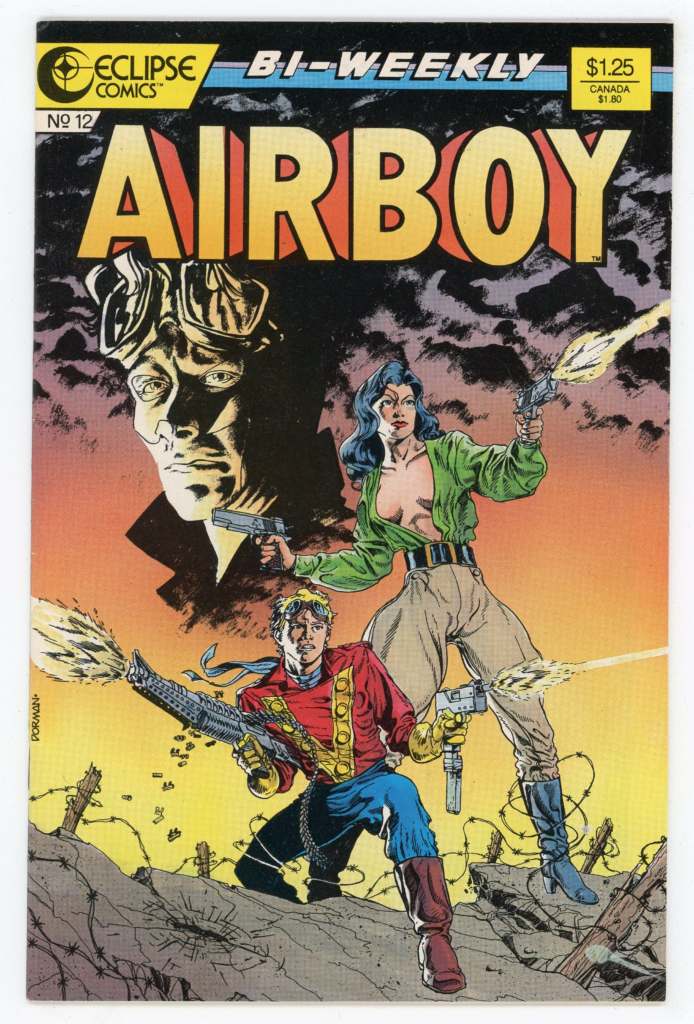Totally Eclipse

Generation X is the last comic book generation.
Don’t get me wrong, storytelling by sequential art will be a thing so long as humans are humans but an adolescent boy sitting on the basement steps immersed in a pamphlet reading stories of the fantastic and superhuman will not happen again. The comic book industry could have planted seed corn in the 1990s but chose to eat it instead. The culture has been skipped for two generations and that is more than enough to end it.
The comic book shop is just one more thing, like small book shops and dime stores whose passing a middle-aged man can feel melancholy for.
When I was a kid there was no such thing as a comic book shop. There was only the drugstore turnstile.
The only issues available to you were the ones that were on that turnstile. If you were following a prolonged story arc and your local five and dime didn’t carry it that month you just plain missed that episode of the story.
Your only hope of being able to catch up with it is if you were enough of a nerd to go to a comic book convention. There you would find a herd of tubby guys who loved comics enough to load up a bunch of long-boxes into their creepy-ass windowless vans (with bad mural art on them) and drive from convention to convention. The more sensible ones had day jobs to support them but they all wanted to make it in comics and it just wasn’t going to happen for them due to the fact that the openings were very limited.
Then in the early 1970s, a guy named Phil Seuling got DC and Marvel to agree to a new system in which he would act as their middleman. They didn’t actually have one that was dedicated strictly to comics before then.
That changed everything for the comic book guys. The first comic book shops of the Seventies flopped but they paved the way for the totally gnarly comic book shops of the Eighties. Now these shops, by comic book nerd for comic book nerds, created a marketplace for independent comic publishers.
When I was a young guy in the eighties my favorite stops on my journeys from somewhere to nowhere and back to my apartment were in no particular order; the mall, the arcade, the pre-Blockbuster video rental shack, and the comic book store.
Now back then a comic book store was much more of a One Stop Nerd Shop. There was usually a vastly better selection of science fiction and fantasy books than you would find at Walden Books. If you wanted gaming books, dice, magazines, and mods that was where you went. In the very early 80s, there would be one pegboard with baggies containing floppy disks (and by that I mean they actually were floppy) that had little stickers on them with dot matrix printed titles like Pitfall, Andromeda Conquest, and Escape from Castle Wolfenstein.
But those were sidelines, their bread and butter were comic books.
The top-shelf bags and long boxes were believe it or not a viable business strategy back then. You weren’t going to get rich but you could dream of hitting it out of the park and becoming the American Shonen Jump, it didn’t seem impossible in the 80s. It honestly felt like America was working the way it was supposed to again.
What made these shops so rad was that in the 1980s there was a sudden flood of independent creators. Diamond had yet to achieve a stranglehold over the industry so it was possible for a micropress to pump out some cheap black and white pamphlets and sell them to the indie shops.
And everybody’s favorite publisher was Eclipse.
Eclipse was one of the new breed of comic book publishers that offered IP ownership for its creators which attracted top-shelf talent like adolescent boys to their fathers’ Playboy stash. Guys like Alan Moore, Steve Ditko, Timothy Truman, Mark Evanier, Steve Gerber, and a few others who weren’t as well known at the time like James Hudnall and Chuck Dixon.
Eclipse got its start in the late 1970s publishing creator-owned graphic novels, getting their start in of all places, Heavy Metal.
Part of what made the comic book scene so huge in the 1980s was Action Comics #1. When Superman’s first appearance in the funny books went for over a million at auction the non-comic book people suddenly perked up and started marching into shops with names like Dragon’s Horde Comics and bought up literally anything with a #1 issue number. And thanks to the indies there were a lot more ‘number ones’ available than usual.
From 1983 through 1985 Eclipse’s reliable top seller was DNAgents. It did frequently break into the top ten list against DC and Marvel.

DNAgents was about a teen team… (Okay teen is kind of a relative term here as they were genetic constructs). The DNAgents were a privately owned superhero team, held in thrall by a major corporation. Yes, it was naturally a greedy 80s corporation. What made them stand out was that the DNAgents were the first Generation X team of superheroes. Their alienation from the previous generations reflected our own. They weren’t in control of their own fate, and some of them were as over-sexualized as we were. Don’t get me wrong there was no hardcore or even softcore in this title but the leader, Rainbow, dabbled in modest, nude modeling.

Deal with it.
I’m not sure if there was ever a single issue of an Eclipse title that was approved by the Comic Books Code.
The nude modeling thing was something that started with Eclipse’s best-known title today, The Rocketeer.

The Rocketeer is I’m sad to say the only Eclipse title that is remembered by the general public today and that is only because they saw the cheesy but well-meaning Disney movie.
And technically, it started with Pacific Comics but when that company folded, Dale Stevens transferred the flag to Eclipse.
Anyway, here’s the thing; nerds beget nerds or at least from 1965 to 1980 they could manage it. And what nerd Dads geeked out over back then were reprints of Conan and Doc Savage. When they got stuck on bedtime story duty for their sons those were the books that got dusted off. Or they did if you were lucky.
Consequently, there were quite a few members of the Generation X comic book reading populace that could touch base with Cliff Secord.
The Rocketeer was about an airplane racer in the Thirties named Cliff Secord, an average, everyday Joe with bad taste in women who was a little down on his luck and surprisingly that had nothing to do with his girlfriend Betty.

Cliff needed a win. He lived in the 1930s, a world with no social safety net except the hard-packed earth below. If Cliff was going to avoid Wiley Coyote’s frequent fate he had to be the fastest man in the air. As exceptional luck would have it fate was on his side. A couple of gangsters tried to steal his plane but the coppers nabbed them before they could get away, it turns out they left something in his cockpit.
The rocket backpack was invented by Doc Savage. Gangsters want it, the Feds want it, Doc Savage wants it and the freaking Nazis want it. Cliff just wants a win at the Nationals and for his girlfriend Betty to stop being a girlie magazine model.
The real attraction of the rocketeer was the throwback mystique to the serials which Generation X could just barely connect with combined with their now frustrated desire to be astronauts.
Eclipse quite did well with its The Rocketeer revival. However, it was with this title they discovered they had a problem with their creator IP ownership model. The IP owner could just up and quit and the publisher was out of luck.
They needed a title that Eclipse Comics owned the rights to and one with a hero that preferably reminded readers of The Rocketeer and who also had a brunette girlfriend with a prominent rack

Airboy by “The Legend” Chuck Dixon filled the bill nicely. Airboy was created in 1942 and ceased publication during the Korean War. The intellectual property came pre-equipped with a hero who was already wearing Cliff Secord’s leather jacket, jodhpurs, and cavalry boots.. Arguably, the Rocketeer had cribbed heavily from the OG Airboy to include the girlfriend with the prominent décolletage.
Valkyrie was easily the fan favorite then, and remains so now.

Today the rights to Airboy and Friends are pretty damn confusing but he has drifted back into publication as late as 2022.
I will be going into these titles in depth at later dates.
Sadly, every boom has to have a bust. The 80s comic book boom was no different. Eventually, the non-nerd speculators figured out that waiting forty years to sell a comic book was not exactly getting rich quick, cashed out, and wandered off. A lot of shops were badly hurt because they had purchased some top-shelf halo titles at boom-inflated prices to get people in the door and now couldn’t unload them, or rather they would have to mark them down to current market prices which is a major problem if you bought them at the peak of the market and on credit. That was survivable but the collapse of the speculator’s market was a disaster if you had expanded to meet that demand. There was a wave of comic shop closures at the end of the eighties.
Eclipse had started with the best of intentions with its creator-owned content model. The fundamental problem with this is that they did not own their own bread and butter titles and the creators were free to take those titles elsewhere or just shut down the title to pursue other projects for a while. Eclipse was in a really bad position, it had created a new market but was unable to survive competition within that market. Malibu, Dark Horse, Valiant, and Image ate Eclipse’s lunch. On top of market reality, it had a string of bad luck black swans landing on top of it. Everything from a messy divorce by the publishers to a flood that destroyed its backroom inventory.
In 1993 Eclipse’s last publication was its own forthcoming catalog of ghost titles. Come 1995 it went into Chapter 11 and Todd MacFarlane ended up buying up their remaining IPs for $25,000.
While Eclipse is only a memory today, its spirit lives on elsewhere.


